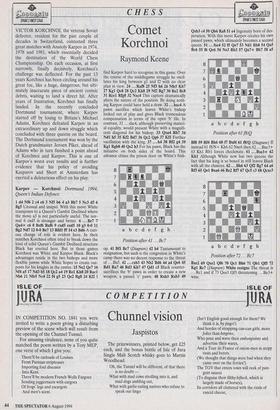., ;01D01._W i SPAIN'S FINEST CAVA
CHESS
Ic,.0110A111 ill SPAIN'S FINEST CAVA
Comet Korchnoi
Raymond Keene
VICTOR KORCHNOI, the veteran Soviet defector, resident for the past couple of decades in Switzerland, contested three great matches with Anatoly Karpov in 1974, 1978 and 1981, which essentially decided the destination of the World Chess Championship. On each occasion, at first narrowly, finally decisively, Korchnoi's challenge was deflected. For the past 13 years Korchnoi has been circling around his great foe, like a huge, dangerous, but ulti- mately inaccurate piece of ancient cosmic debris, waiting to land a direct hit. After years of frustration, Korchnoi has finally landed. In the recently concluded Dortmund tournament, where Karpov started off by losing to Britain's Michael Adams, Korchnoi defeated Karpov in an extraordinary up and down struggle which concluded with three queens on the board. The Dortmund tournament was won by the Dutch grandmaster Jeroen Piket, ahead of Adams who in turn finished a point ahead of Korchnoi and Karpov. This is one of Karpov's worst ever results and is further evidence that his policy of avoiding Kasparov and Short at Amsterdam has exerted a deleterious effect on his play.
Karpov — Korchnoi: Dortmund 1994; Queen's Indian Defence.
1 d4 Nf6 2 c4 e6 3 N13 b6 4 a3 Bb7 5 Nc3 d5 6 Bg5 Unusual and insipid. With this move White transposes to a Queen's Gambit Declined where the move a3 is not particularly useful. The nor- mal 6 cxd5 is stronger and better. 6 ...Be7 7 Qa4+ c6 8 Bxf6 Bxf6 9 cxd5 exd5 10 g3 0-0 11 Bg2 Nd7 12 0-0 Be7 13 Rfdl f5 14 e3 Bd6 A curi- ous change of role is evident here. In their matches Korchnoi often tried to break down the kind of solid Queen's Gambit Declined structure Black has erected here. But in those games Korchnoi was White and Karpov Black. Black's advantages reside in the two bishops and more flexible pawns while White hopes to create out- posts for his knights in the centre. 15 Ne2 Qe7 16 Nf4 a5 17 Nd3 b5 18 Qc2 a4 19 Ref Kh8 20 Racl Nb6 21 NfeS Nc4 22 f4 g5 23 Qe2 Rg8 24 Kf2 I find Karpov hard to recognise in this game. Over the course of the middlegame struggle he oscil- lates his king between gl and f2 with no clear plan in view. 24 ... Raf8 25 Nf3 h6 26 NfeS Kh7 27 Kg1 Qe8 28 Qc2 Kh8 29 Nfl Rg7 30 Reg Bc8 31 Reel Rfg8 32 Nxc4 This capture dramatically alters the nature of the position. By doing noth- ing Karpov could have held a draw. 32 —13=4 A pawn sacrifice which leaves White's bishop locked out of play and gives Black tremendous compensation in terms of the open `b' file. In contrast, 32 ... dxc4, although preserving materi- al equality, would present White with a magnifi- cent diagonal for his bishop. 33 Qxa4 Rb7 34 Ndl h5 35 Kf2 Bd7 36 Qc2 Qg6 37 Kfl Further vacillation with the king. 37 ...h4 38 Rf2 g4 39 Kgl RgbS 40 Qe2 h3 For his pawn, Black has the initiative on both sides of the board. This advance closes the prison door on White's bish- op. 41 Bfl BC (Diagram) 42 b4 Tantamount to resignation, but such is the congestion in White's camp there was no decent response to the threat of ... Ba5. 42 ex133 43 Nb2 Bd6 44 a4 Qe6 45 Rdl Raj 46 Rd3 Kh7 47 Qdl c5 Black counter- sacrifices the 'b' pawn in order to create a new weapon, a passed 'c' pawn. 48 Rxb3 Rxb3 49 Qxb3 c4 50 Qb6 Ra8 51 e4 Ingenuity born of des- peration, With this move Karpov creates his own passed pawn, which ultimately becomes a second queen. 51 ... fxe4 52 f5 Qe7 53 Ndl Rb8 54 Qa5 Bc6 55 f6 Qe6 56 Ne3 Rb3 57 Qa7+ Bb7 58 a5
Position after 61 f8IQ
Bf8 59 Rf4 Bh6 60 f7 Bxf4 61 f8/Q (Diagram) If instead 61 f8/N+ Kh6 62 Nxe6 then 62 ...Bxe3+ 63 Khl Rb1 forces checkmate. 61 ...Bxe3+ 62 Khl Although White now has two queens the fact that his king is so boxed in still leaves Black with all the chances. 62 ... Bh6 63 Qf2 Bg7 64 a6 RE3 65 Qel Bxa6 66 Bet R17 67 Qc5 c3 68 Qcxc3
Position after 72 . . . Rc7
Bxe2 69 Qxe2 Qf6 70 Qcl Bh6 71 Qbl Qf5 72 Kgl Rc7 (Diagram) White resigns The threat is ...Rcl and if 73 Qeel Qf3 threatening ... Be3+ wins.


















































 Previous page
Previous page